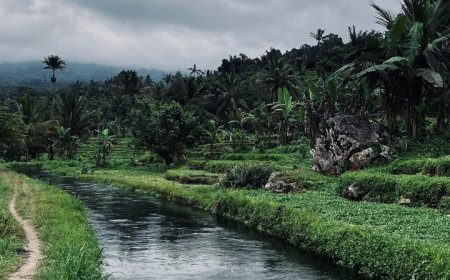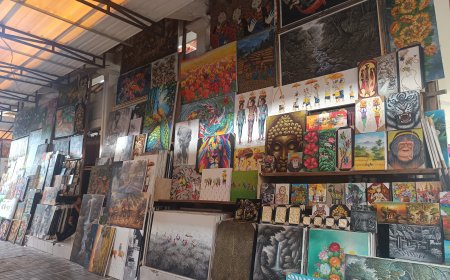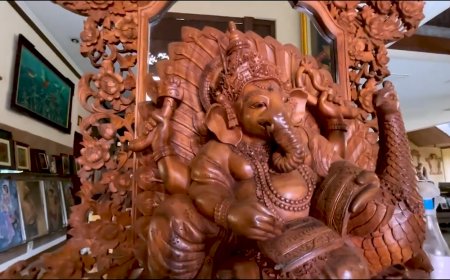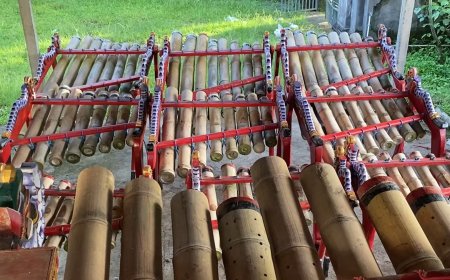Historical Traces of the 14th Century Intangible Cultural Heritage of Kamasan Wayang Paintings
Kamasan Wayang Painting, originating from Klungkung, Bali, is a precious part of Indonesia's cultural heritage. This painting has a long history dating back to the 14th century, depicting characters from ancient wayang performances, a traditional art that combines vibrant, contrasting colors rich in religious and moral significance. It is an Intangible Cultural Heritage full of meaning that has been submitted to UNESCO's ICH.

Bali is a part of Indonesia that is rich in culture and captivating art. One of the most prominent forms of art is traditional painting. One of the most remarkable traditional painting forms is the Kamasan Wayang Painting, originating from the Kamasan Village in Klungkung, Bali, Indonesia. This art has a long history dating back to the 14th century.
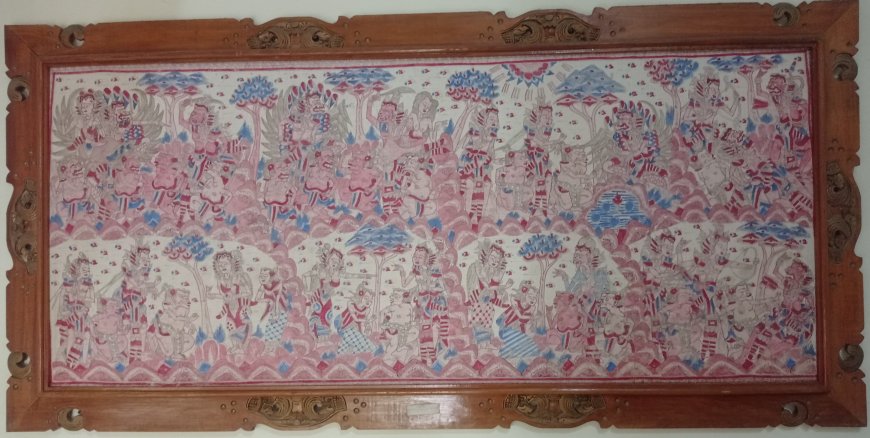
Wayang Kamasan Painting (Photo Source : Editorial Collection)
During this time, the island of Bali was ruled by the descendants of Sri Kresna Kepakisan from the Majapahit Kingdom, and the rulers of this era were often referred to as "Dalem." One of the most famous was Dalem Sri Waturenggong, a direct descendant of Sri Kresna Kepakisan. At that time, Dalem Waturenggong ruled the Kingdom of Bali, also known as the Gelgel Kingdom, which held sway over the regions of Bali Island, the East Java coast, Lombok, and Sumbawa. Dalem Waturenggong had a deep interest in the arts, and he transformed the Kamasan Village, located north of Gelgel, into a center for education, religion, and cultural arts. Since then, the arts flourished and continue to thrive, including the classical paintings distinctive to Klungkung, known as Kamasan Wayang Paintings.
Kamasan Wayang Paintings typically depict characters from wayang performances, a traditional form of performing arts in Indonesia. The characters in these paintings are usually human or mythological beings, such as gods, goddesses, or wayang warriors. These paintings are often used as decorations in religious and cultural ceremonies and as a medium to narrate ancient stories from the epics of Ramayana and Mahabharata.
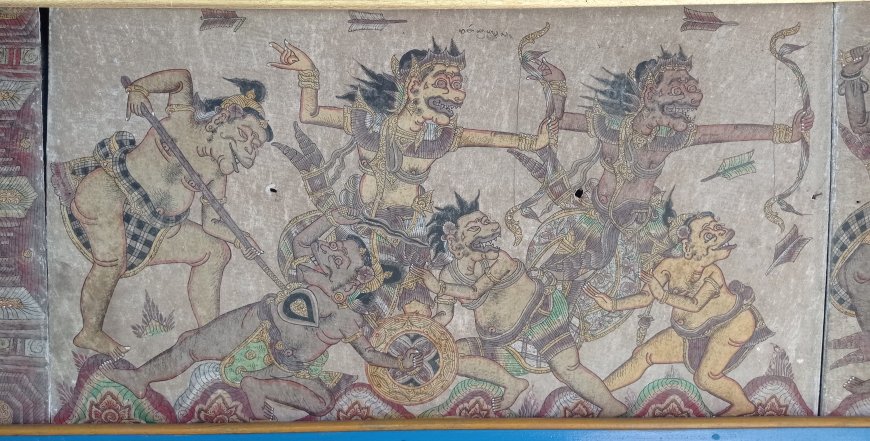
Wayang Kamasan Painting (Photo Source : Editorial Collection)
One of the distinctive features of Kamasan Wayang Paintings is the use of vibrant and contrasting colors. These paintings typically use a basic palette of colors such as red, yellow, and gold, obtained from natural materials like limestone (Batu Pere) for a yellowish-brown hue, among other natural pigments. These colors are applied to a canvas made from coarse fabric, which is dipped in rice porridge powder, dried, and smoothed, giving the Kamasan Wayang Paintings their authentic and visually strong characteristics.
In addition to their striking colors, Kamasan Wayang Paintings are known for their intricate details. Every character and element in these paintings is treated with precision. Often, the paintings are adorned with complex floral and leaf motifs, creating an impression of fertility and natural beauty.
Kamasan Wayang Paintings are not just visual decorations but also carry deep cultural meaning in Bali, especially in Kamasan, Klungkung. Each character in these paintings holds symbolic significance related to religious and moral teachings. For example, characters from the Ramayana and Mahabharata are often portrayed as symbols of virtue and human flaws.
Moreover, Kamasan Wayang Paintings are used in various religious ceremonies. They serve as instruments for honoring deities and ancestral spirits and for bestowing blessings and protection. In this context, these paintings are not just works of art but also tools for spiritual communication.
The beauty of Kamasan Wayang Paintings also lies in the hard work and skill of the artists who create them. The process of making these paintings is intricate and demands great precision. These artists pass down their knowledge from generation to generation, ensuring that this tradition remains alive and continues to evolve for future generations.
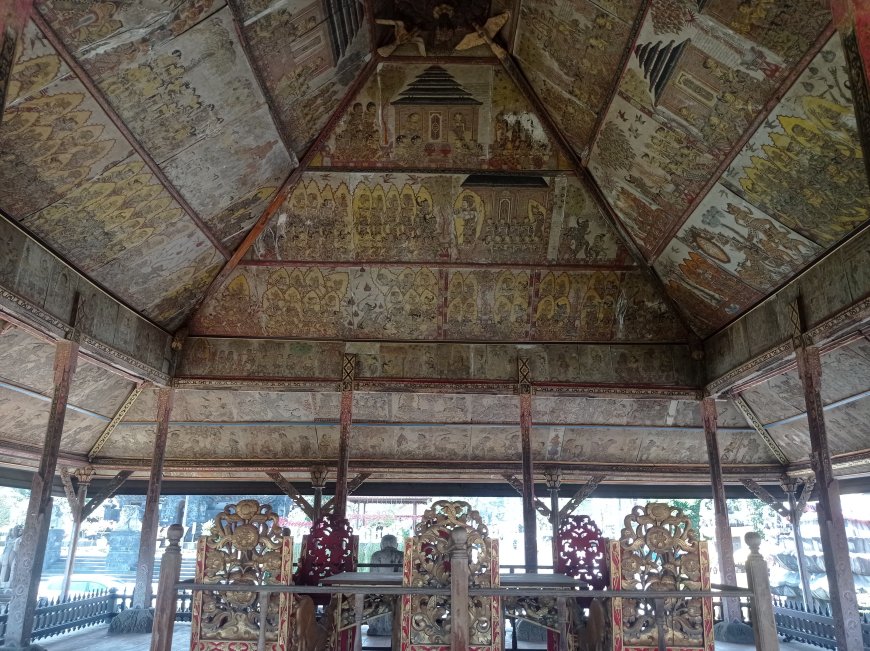
Wayang Kamasan Painting as An Ornament on Ceiling of Kertha Gosa (Photo Source : Editorial Collection)
Kamasan Wayang Paintings are a shining example of Indonesia's traditional art. They are a classic work rich in meaning, adorning not only temple and palace walls but also celebrating the culture and richness of Bali, Indonesia. These paintings are not just visual art; they are a means of cultural and spiritual communication. Through their bright colors, fine details, and symbolic meanings, Kamasan Wayang Paintings invite us to understand and appreciate the incredible cultural heritage of Indonesia.
The uniqueness of Kamasan Wayang Art is so intriguing that the Klungkung Regency government has registered it as a Non-Material Cultural Heritage, a recognition approved by the Ministry of Education, Culture, Research, and Technology of the Republic of Indonesia on January 1, 2013, as reported on the official website warisanbudaya.kemdikbud.go.id. Furthermore, Kamasan Wayang Paintings are currently under consideration to be one of the 10 Non-Material Cultural Heritages submitted by the Ministry of Education, Culture, Research, and Technology of the Republic of Indonesia for possible inclusion in UNESCO's Intangible Cultural Heritage list. Since each country can only submit one heritage item within a certain timeframe, it is crucial to preserve and safeguard this cultural heritage, Kamasan Wayang Paintings.




















